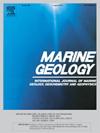Sediment flux variation and environmental implications in the East Hainan Coast, South China Sea during the last 20 ka—a luminescence chronological investigation
IF 2.6
3区 地球科学
Q2 GEOSCIENCES, MULTIDISCIPLINARY
引用次数: 0
Abstract
Sediments deposited on the continental shelf are indicative of paleo sea-level and terrestrial-marine interaction. A reliable chronology of the continental shelf sediments is required for paleoenvironmental and paleoceanographical investigations. In this study, the chronology of the terrestrial-to-marine sedimentary sequence in the East Hainan Coast, South China Sea (SCS), was established using luminescence and radiocarbon dating approaches. The luminescence characteristics of quartz post-infrared (pIR)-blue and pIR-pulsed OSL signals, K-feldspar and polymineral IR and post-IR IRSL (pIRIR) signals, were thoroughly studied and compared using six representative samples. The quartz pIR-blue and pIR-pulsed OSL ages are generally consistent with each other. The pIRIR150 (subscript shows the stimulation temperature) ages slightly underestimate the associated quartz luminescence ages, likely due to fading under-correction. Chronology of the sediments was established using the post-IR blue OSL ages, indicating the terrestrial-to-marine sedimentation occurred during the last 20 ka. Episodic sedimentation in the East Hainan Coast was revealed by slow sedimentation during the periods of pre- (19.7–11.5 ka) and mid-Holocene (8.7–7.0 ka), while rapid sedimentation occurred during the early Holocene (11.5–8.7 ka). The exposed environment and the Younger Dryas cold event may be attributed to the slow sedimentation during the periods of ca. 19.7–14.3 and 12.9–11.5 ka, whilst the rapidly rising sea-level during 14.3–12.9 ka resulted in rare sedimentation under the coastal to neritic environments. Tremendous fluvial input corresponding to considerable precipitation resulted from intensification of the East Asian Summer Monsoon during the early Holocene (11.5–8.7 ka). Deepening water level, inundation of the Qiongzhou Strait and vegetation densification, may change the process of sediment transportation, source and flux, causing slow sedimentation in the eastern inner shelf to the Hainan Island in the mid-Holocene (8.7–7.0 ka).
南海海南东岸近20 ka-a发光年代学沉积物通量变化及其环境意义
陆架上沉积的沉积物是古海平面和海陆相互作用的标志。古环境和古海洋学研究需要可靠的陆架沉积物年表。本文采用发光测年和放射性碳测年方法,建立了南海海南东部陆相-海相沉积序列的年代学。利用6个代表性样品,对石英后红外(pIR)蓝光和pIR脉冲OSL信号、钾长石和多矿物红外和后红外IRSL (pIRIR)信号的发光特性进行了深入研究和比较。石英的pIR-blue年龄与pIR-pulsed OSL年龄基本一致。pIRIR150(下标为激发温度)年龄略低于相关石英发光年龄,可能是由于校正不足导致的衰落。利用ir后蓝色OSL年龄建立了沉积物年代学,表明陆-海沉积发生在最近20 ka。海南东部沿海前(19.7 ~ 11.5 ka)和中全新世(8.7 ~ 7.0 ka)为缓慢沉积期,全新世早期(11.5 ~ 8.7 ka)为快速沉积期。19.7 ~ 14.3 ka和12.9 ~ 11.5 ka期间的缓慢沉积可能是暴露环境和新仙女木期冷事件的主要原因,而14.3 ~ 12.9 ka期间海平面的快速上升导致了沿海至浅海环境下的罕见沉积。全新世早期(11.5-8.7 ka)东亚夏季风的增强导致了大量的河流输入和大量降水。全新世中期(8.7-7.0 ka),琼州海峡的水位加深、淹没和植被的高密度化可能改变了沉积物输运过程、来源和通量,导致东部内陆架向海南岛缓慢沉积。
本文章由计算机程序翻译,如有差异,请以英文原文为准。
求助全文
约1分钟内获得全文
求助全文
来源期刊

Marine Geology
地学-地球科学综合
CiteScore
6.10
自引率
6.90%
发文量
175
审稿时长
21.9 weeks
期刊介绍:
Marine Geology is the premier international journal on marine geological processes in the broadest sense. We seek papers that are comprehensive, interdisciplinary and synthetic that will be lasting contributions to the field. Although most papers are based on regional studies, they must demonstrate new findings of international significance. We accept papers on subjects as diverse as seafloor hydrothermal systems, beach dynamics, early diagenesis, microbiological studies in sediments, palaeoclimate studies and geophysical studies of the seabed. We encourage papers that address emerging new fields, for example the influence of anthropogenic processes on coastal/marine geology and coastal/marine geoarchaeology. We insist that the papers are concerned with the marine realm and that they deal with geology: with rocks, sediments, and physical and chemical processes affecting them. Papers should address scientific hypotheses: highly descriptive data compilations or papers that deal only with marine management and risk assessment should be submitted to other journals. Papers on laboratory or modelling studies must demonstrate direct relevance to marine processes or deposits. The primary criteria for acceptance of papers is that the science is of high quality, novel, significant, and of broad international interest.
 求助内容:
求助内容: 应助结果提醒方式:
应助结果提醒方式:


